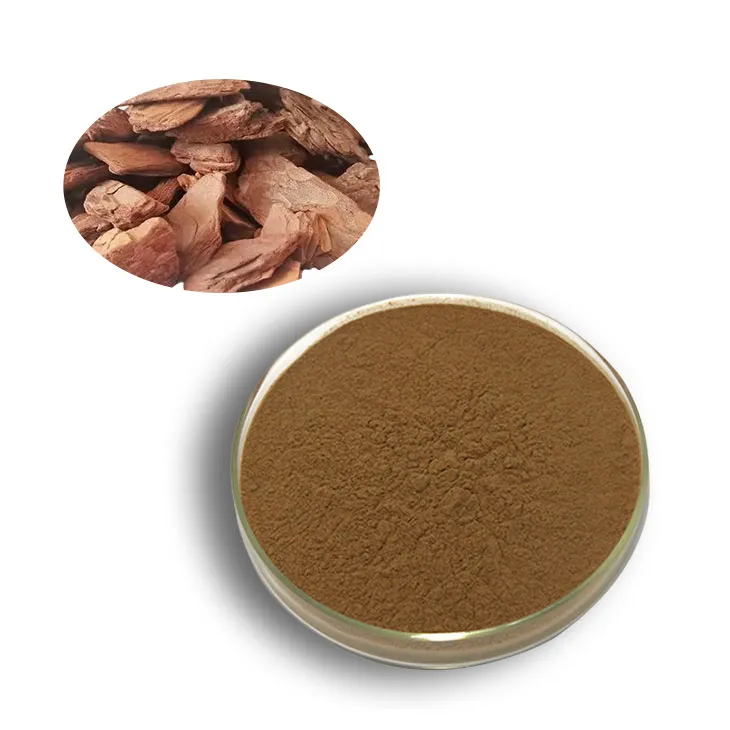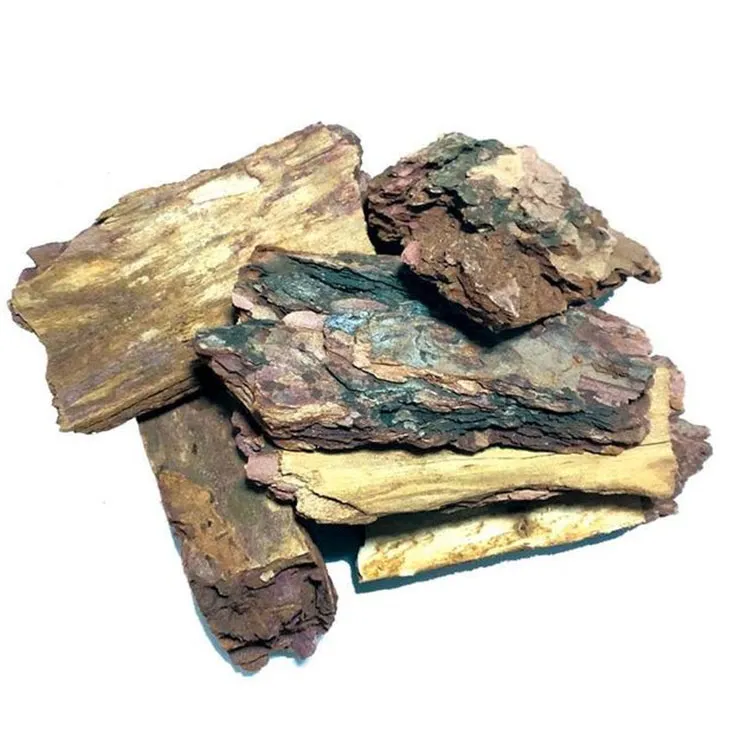- 0086-571-85302990
- sales@greenskybio.com
How to extract pine bark extract powder from plants?
2024-11-28

1. Introduction
Pine bark Extract Powder has been recognized for its numerous health - beneficial properties. It contains bioactive compounds such as proanthocyanidins, which are known for their antioxidant, anti - inflammatory, and cardiovascular - protective effects. Extracting this valuable powder from pine bark is a process that requires careful consideration of various factors, from the selection of the pine trees to the final purification of the extract. This article will explore in detail the steps involved in extracting Pine bark Extract Powder from plants.

2. Selection of Pine Trees
The first and crucial step in the extraction process is the selection of suitable pine trees. Only healthy pine trees should be considered for bark extraction.
2.1 Health Criteria
- Trees should be free from diseases. Common pine tree diseases such as pine wilt disease, caused by the pinewood nematode, can affect the quality of the bark. If a tree is infected, the physiological processes within the tree may be disrupted, leading to changes in the composition of the bark compounds.
- They should also be pest - free. Pests like bark beetles can damage the bark structure. When the bark is damaged by pests, it may introduce unwanted substances or cause a decrease in the concentration of the desired bioactive compounds.
2.2 Growth Conditions
- The growth environment of the pine trees also plays an important role. Pine trees growing in areas with proper sunlight exposure tend to have better - developed bark. Adequate sunlight is necessary for the tree's photosynthesis, which in turn affects the biosynthesis of various compounds in the bark.
- Soil quality is another factor. Trees growing in well - drained, nutrient - rich soil are more likely to produce high - quality bark. For example, soil with an appropriate balance of nitrogen, phosphorus, and potassium can support the healthy growth of pine trees and contribute to the formation of bioactive compounds in the bark.

3. Bark Collection
Once the suitable pine trees are identified, the next step is to carefully collect the bark. This process should be carried out in a way that causes minimal harm to the tree.
3.1 Timing of Collection
- The time of year for bark collection can impact the quality and quantity of the extract. In general, late spring or early summer is often a good time. During this period, the tree is in an active growth phase, and the bark may contain higher levels of bioactive compounds.
- However, it is important to note that regulations regarding bark collection may vary by region. Some areas may have restrictions during certain seasons to protect the tree population and the ecosystem.
3.2 Collection Methods
- One common method is to use a specialized bark - stripping tool. This tool should be sharp enough to cleanly remove the bark but not so sharp that it cuts too deeply into the tree's cambium layer. Cutting into the cambium can severely damage the tree and may even lead to its death.
- Another approach is to carefully peel the bark by hand, especially for smaller branches or areas where more precision is required. This method requires trained personnel to ensure that only the outer bark is removed without causing unnecessary harm to the tree.

4. Extraction Process
After the bark is collected, the extraction process begins. There are several methods for extracting the active compounds from pine bark, with solvent extraction being one of the most commonly used.
4.1 Solvent Extraction
-
Ethanol as a Solvent
- Ethanol is a popular choice for solvent extraction. It has several advantages. Firstly, it is relatively safe to handle compared to some other solvents. It is also miscible with water, which is important as the pine bark may contain water - soluble compounds in addition to lipid - soluble ones.
- The extraction process using ethanol typically involves soaking the pine bark in ethanol solution. The ratio of bark to ethanol can vary depending on the desired concentration of the extract. For example, a common ratio could be 1:5 (bark to ethanol by weight), but this can be adjusted based on experimental requirements.
- The mixture is then stirred or agitated for a certain period. This helps to increase the contact between the solvent and the bark, allowing for better dissolution of the active compounds. Stirring can be done mechanically using a stirrer or by gentle shaking in a closed container.
-
Other Solvents
- While ethanol is widely used, other solvents can also be considered. For example, methanol can be used in a similar way. However, methanol is more toxic than ethanol and requires more careful handling.
- Some researchers have also explored the use of supercritical fluids such as supercritical carbon dioxide. Supercritical carbon dioxide has the advantage of being non - toxic and can be easily removed from the extract after extraction. However, the equipment required for supercritical fluid extraction is more complex and expensive.
4.2 Temperature and Time Considerations
- Temperature plays a role in the extraction process. In general, a higher temperature can increase the rate of extraction as it can enhance the solubility of the compounds in the solvent. However, excessive temperature can also cause degradation of some bioactive compounds. For example, if the temperature is too high during ethanol extraction, some of the proanthocyanidins may be oxidized or otherwise chemically modified.
- The extraction time also needs to be optimized. A longer extraction time may lead to a higher yield of the extract, but it also increases the risk of extracting unwanted substances or causing degradation of the desired compounds. A typical extraction time for ethanol extraction could range from a few hours to several days, depending on the specific requirements.
5. Purification
Once the extraction is complete, the resulting solution contains not only the desired pine bark extract but also various impurities. Purification steps are necessary to obtain high - quality Pine bark Extract Powder.
5.1 Filtration
- Filtration is often the first step in purification. A simple filtration using filter paper or a filter membrane can remove large particles such as pieces of bark debris. This helps to clarify the extract solution.
- For more efficient filtration, vacuum filtration can be used. Vacuum filtration can speed up the filtration process by applying a negative pressure, which forces the liquid through the filter more quickly.
5.2 Separation Techniques
-
Centrifugation
- Centrifugation can be used to separate different components in the extract based on their density differences. By spinning the extract at a high speed in a centrifuge, heavier particles or droplets can be separated from the lighter ones. This can help to further purify the extract by removing some of the suspended impurities.
-
Chromatography
- Chromatography is a more advanced separation technique. There are different types of chromatography that can be applied to pine bark extract purification. For example, column chromatography can be used to separate the different bioactive compounds based on their affinity for the stationary phase and the mobile phase.
- High - performance liquid chromatography (HPLC) is another option. HPLC can provide a high - resolution separation of the components in the extract, allowing for the isolation of the purest form of the pine bark extract.
5.3 Drying and Powder Formation
- After purification, the extract needs to be dried to form a powder. One common drying method is freeze - drying. Freeze - drying involves freezing the extract solution first and then removing the water or solvent by sublimation under reduced pressure. This method helps to preserve the bioactive compounds as it minimizes thermal degradation.
- Another drying method is spray - drying. In spray - drying, the extract solution is sprayed into a hot air stream, and the solvent is evaporated quickly, leaving behind a powder. Spray - drying is a more rapid process compared to freeze - drying but may require more careful control of the drying conditions to ensure the quality of the powder.
6. Conclusion
Extracting pine bark extract powder from plants is a multi - step process that requires attention to detail at each stage. From the careful selection of pine trees to the final purification and powder formation, every step is crucial in obtaining a high - quality product. Understanding this extraction process not only allows for better utilization of pine bark extract powder but also promotes the sustainable development of the pine tree resources. By following proper extraction techniques, we can ensure that the health - beneficial properties of pine bark extract powder are maximally preserved and made available for various applications in the fields of health, cosmetics, and food.
FAQ:
What are the key factors in selecting pine trees for pine bark extract powder extraction?
The key factor is to choose pine trees that are in healthy growth without diseases or pests. This ensures that the bark contains the desired compounds and is free from contaminants that might be associated with diseased or pest - infested trees.
How can the bark be collected with minimal harm to the tree?
When collecting the bark, it should be done carefully. Specialized tools can be used to peel off only a small amount of bark at a time, following proper forestry or gardening practices. This helps to avoid excessive damage to the tree trunk and branches, allowing the tree to continue to grow and thrive.
Why is solvent extraction, such as using ethanol, a common method for extracting pine bark extract powder?
Ethanol is a common solvent for extraction because it can effectively dissolve the active compounds present in the pine bark. It is also relatively safe to handle compared to some other solvents. Additionally, ethanol has the ability to penetrate the cell walls of the bark tissue and extract a wide range of bioactive substances.
What are the typical purification steps involved in obtaining high - quality pine bark extract powder?
Typical purification steps may include filtration to remove large particles, centrifugation to separate different phases, and chromatography techniques to further separate and purify the desired compounds. These steps help to eliminate impurities such as resins, tannins, and other unwanted substances, resulting in a high - quality pine bark extract powder.
Are there any environmental concerns associated with the extraction of pine bark extract powder?
Yes, there can be environmental concerns. For example, if the bark is collected in an unsustainable manner, it can harm the pine trees and the overall forest ecosystem. Also, the use and disposal of solvents need to be carefully managed to avoid pollution. To address these concerns, sustainable harvesting practices should be adopted, and proper waste management procedures for solvents should be in place.
Related literature
- Extraction Techniques for Bioactive Compounds from Pine Bark: A Review"
- "Optimization of Pine Bark Extract Production: From Tree to Powder"
- "The Chemistry and Extraction of Pine Bark Extracts: Current Trends and Future Perspectives"
- ▶ Hesperidin
- ▶ Citrus Bioflavonoids
- ▶ Plant Extract
- ▶ lycopene
- ▶ Diosmin
- ▶ Grape seed extract
- ▶ Sea buckthorn Juice Powder
- ▶ Fruit Juice Powder
- ▶ Hops Extract
- ▶ Artichoke Extract
- ▶ Mushroom extract
- ▶ Astaxanthin
- ▶ Green Tea Extract
- ▶ Curcumin
- ▶ Horse Chestnut Extract
- ▶ Other Product
- ▶ Boswellia Serrata Extract
- ▶ Resveratrol
- ▶ Marigold Extract
- ▶ Grape Leaf Extract
- ▶ New Product
- ▶ Aminolevulinic acid
- ▶ Cranberry Extract
- ▶ Red Yeast Rice
- ▶ Red Wine Extract
-
Astaxanthin
2024-11-28
-
Saffron Extract Powder
2024-11-28
-
Moringa powder
2024-11-28
-
Oat Straw Extract Powder
2024-11-28
-
Green coffee bean Extract
2024-11-28
-
Peppermint Extract Powder
2024-11-28
-
Agaricus Blazei Extract
2024-11-28
-
Hawthorn powder
2024-11-28
-
Lemon Juice Powder
2024-11-28
-
Bamboo Leaf extract
2024-11-28





















